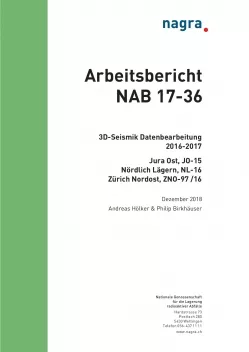
Arbeitsbericht NAB 17-36
3D-Seismik Datenbearbeitung 2016-2017 Jura Ost, JO-15 Nördlich Lägern, NL-16 Zürich Nordost, ZNO-97 /16
Nagra investigates the Opalinus Clay of northern Switzerland as a potential host rock for a deep geological repository for radioactive waste. From September 2015 to February 2017 threedimensional reflection seismic surveys have been acquired across the siting regions Jura Ost, Nördlich Lägern and Zürich Nordost to further explore the local structural geology. The raw survey data are not directly suitable for mapping the subsurface geology. They require a data processing, which yields geologically interpretable reflection seismic images. The report at hand describes this data processing.
Seismic data processing consists of conditioning the raw data (i.e. a data preparation) and the application of one or more imaging procedures. Such data processing requires decisions on the usage of individual processes and the definition of processing parameters. Thus, the results depend on the implementation. Alternative imaging methods have different strengths and weaknesses. For example, they are differently sensitive to a spacial variability of the data density or to lateral variations of the wave propagation velocities. The data processing at hand implements a single-track data conditioning and a multi-track imaging. Methodologically inherent imaging uncertainties are identified and discussed on the basis of alternative images.
Nagra separated the data processing into two subprojects:
- A Quick Look Processing, which had to be completed rapidly as a basis for the Quick Look Interpretation and which primarily utilises reflection seismic imaging methods in time domain.
- A Refinement Processing, which is still to be executed and which shall primarily utilise reflection seismic imaging methods in depth domain.
The report at hand describes the Quick Look Processing and provides a brief outlook on the upcoming Refinement Processing.
The Quick Look Processing products include multiple reflection images and one diffraction image per siting region. The latter is yet an experimental product aiming at a quantification of the degree of heterogeneity in the subsurface. Furthermore, the Quick Look Processing products include various intermediate products such as pre-stack data, derived data and models (first break picks, static corrections, velocity models). The reflection images are discussed in view of their suitability for geological interpretation.
